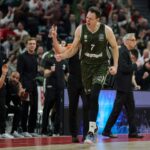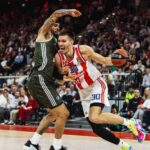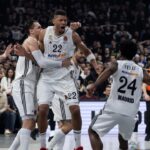 Budapest last night played host to the Harlem Globetrotters, and BallinEurope was among the approximately 4,000 in attendance. Though a generally good time appeared to have been had by all – and particularly, of course, the preteens for whom the team’s brand of tomfoolery is really for – BiE just couldn’t help but wonder at just how relevant this 1920s creation is in the 21st century, despite basketball’s still-burgeoning popularity worldwide.
Budapest last night played host to the Harlem Globetrotters, and BallinEurope was among the approximately 4,000 in attendance. Though a generally good time appeared to have been had by all – and particularly, of course, the preteens for whom the team’s brand of tomfoolery is really for – BiE just couldn’t help but wonder at just how relevant this 1920s creation is in the 21st century, despite basketball’s still-burgeoning popularity worldwide.
With a promise to keep the when-I-was-a-lad curmudgeonly rhetoric to a minimum, BiE can tell you i last saw the Harlem Globetrotters in Budapest in 1999 before a crowd nearly twice the size as last night’s. Having essentially gone the entire decade not having seen the Globetrotters in any form, i thrilled to the old refreshing antics, maybe 80% of which i’d utterly forgotten and thus were nearly as amusing at thirtysomething as at eight years old.
In between then and now, of course, the entire basketball landscape – how it is organized, played and especially watched – has changed utterly, slamming gears into the 21st century and quite possibly leaving the Harlem Globetrotters well behind. It is possible in North America to literally watch 24 hours of back-to-back basketball with a little assistance from TiVo (and certainly many tens of thousands have recently attempted this feat with March Madness in full swing); thanks to the expansion of live-streaming and IPTV technology, anywhere in the world equipped with fiber optics can allow a basketball enthusiast outside the ‘States to do likewise.
Meanwhile, the constant positive evolution of the NBA’s now-showcase happening, i.e. All-Star Weekend, has resulted in an event that gives American audiences what the cancellation of “Wide World of Sports” took away: A once-a-year televisual spectacular of some of the world’s greatest basketball players wowing us all with insane trick shots and monster dunks. Why in my day (uh oh, the old fogey’s bubbling up again), we waited all year for the annual Globetrotters-on-WWOS Sunday; nowadays, kids await the All-Star Game with similar fervor. And basically every domestic league in Europe attempts to duplicate the pageantry and fun of David Stern’s baby.
Of course, in 2010, you don’t have to wait to be oohed and aahed by roundball masters: You’ve got YouTube! You’ve got Dude Perfect and Vince Carter making 85-foot shots and viral videos as an open call to challenges and guys like DJ Steve Porter throwing together soundbite dance mixes to put atop NBA highlights and clips of top NBA stars playing H.O.R.S.E. and, sorry, the Harlem Who?
Last night’s show in Budapest quite frankly demonstrated the precarious balance (and losing battle, it seems) between tradition and the present-day expectations of the basketball audience. While certain gags or riffs on gags are still golden – e.g. the water bucket, anything involving de-shorting a hapless Washington Generals player – these Globetrotters appeared confined by the new restrictions NBA culture has exported.
For example: The noise. You’ve heard it before from any American 35 or older: NBA games these days are a constant squall of stimulation, continually exhorting the crowd to scream “DEE-FENSE” or “make some noise.” (Wasn’t the latter once a euphemism for quite another activity?) Every time a team can bring the ball up leisurely to set up a half-court offense, some cliched hip hop track, dusty “classic rock” single or lame backbeat must drown out the potential for anything other than attention to the game.
Yet, the Globetrotters at their best draw attention to the game – no further bells ‘n’ whistles necessary. Last night, microphoned designated wisecracker High Lite (?) often found himself verbally competing with blaring 90s samples. The result was a lack of that Globetrotters rhythm that traditionally keeps the show moving from trick play to trick play. And it was evident that High Lite couldn’t get going that trademark patter handed down from Globetrotter to Globetrotter since Geese Ausbie; sure, much of the non-native Anglophone audience wouldn’t have gotten 90% of the argot, but hey, there’s a reason why American slang-laden rap sells from Albania to Zaire.
On the subject of trash-talking – that oh-so-necessary aspect of today’s high-level games that the Globetrotters’ Geeses and Gooses themselves first elevated to art form – let’s hope that someone from Harlem Globetrotters Basketball Inc. is reading this piece, because BiE would unabashedly like to state that having the Generals coach getting on the microphone to make insulting “jokes” to and about the city of Budapest was, in the parlance of our times, one great big FAIL.
As for the trick plays themselves, well, again, the dunking was nothing you can’t view on YouTube for far less than the €13.25 cheap seats at last night’s match. Sure, these dudes can get some air and can run the alley-oop off the glass to perfection, but so can any two first-team ACB All-Stars without playing 250 games a year together. By the time the second quarter began, the nth jam failed to impress the most impressionable of Hungarian viewers; the “oohs” and “aahs” elicited from tipoff to first-quarter buzzer had melted away.
Putting things into a historical context also demonstrates the Globetrotters’ current position in the basketball universe. A few significant dates in team history surely includes the following.
 • In 1948, the Globetrotters defeat George Mikan and the Minneapolis Lakers, 61-59; the following year, the Globetrotters also beat the Lakers. These Lakers were back-to-back Basketball Association of America (precursor to the National Basketball Association) champions, having gone 84-34 in the two seasons.
• In 1948, the Globetrotters defeat George Mikan and the Minneapolis Lakers, 61-59; the following year, the Globetrotters also beat the Lakers. These Lakers were back-to-back Basketball Association of America (precursor to the National Basketball Association) champions, having gone 84-34 in the two seasons.
• In 1953, the Globetrotters draw a crowd of 36,256 at Los Angeles Memorial Coliseum in Los Angeles, at that time the largest audience ever at a basketball game.
• In 1958, Wilt Chamberlain, the top prospect in NCAA basketball by a country mile, eschews his final year at University of Kansas to play with the Globetrotters.
• In 1963, the team led by Geese Ausbie and Curly Neal plays a game in Vatican City, for Pope Paul VI and a private audience.
• For the Winter Olympics of 1980, the Globetrotters are named the “Olympic Games official Goodwill Ambassadors.”
• In 1998, the Globetrotters receive live coverage on ESPN2 when the team plays the franchise’s 20,000th game.
• The Harlem Globetrotters are inducted into the Basketball Hall of Fame in Springfield in 2002. The official entry includes mentions of former players Inman Jackson, Marques Haynes, Geese Ausbie, Goose Tatum, Fred “Curly” Neal and Meadowlark Lemon; the most recently retired of this group is Neal, who retired from Globetrotters ball in 1985.
• Neal is inducted into the North Carolina Sports Hall of Fame.
Now how unimaginable would the occurrence of most of the events listed above – some of them seemingly incredibly mundane – be today? The current record for attendance at a basketball game is the 100,000-plus-whatever-the-final-count-was set at this year’s NBA All-Star Game; think the Globetrotters’ll be breaking that mark anytime soon…?
As for meeting with figures papal and presidential (pictured above is then-First Lady Betty Ford with Meadowlark Lemon), well, one would figure Dirk Nowitski and the Los Angeles Lakers, respectively, to sooner get audiences with those respective venerated audiences than a team on which no player is anywhere near a household name.
Top prospects joining the Globetrotters? No longer bloody likely, it seems. Though American players have always had the option to play overseas, the proliferation and growth of most Western European domestic leagues in 1990s combined with an effective doubling to tripling of job openings thanks to leagues formerly closed off behind the Iron Curtain, young ballplayers in the ‘States are more aware of opportunities to play elsewhere than ever. Plus, as many US and European players discover, scoring a professional job with even a mid-level team can fulfill one’s own globetrotting desires without taking part in a full-time traveling show.
In 2007, the Globetrotters held their inaugural “draft” (Seriously? Who had the lottery pick? The Generals?) and took on Anthony “Ant” Atkinson of Barton College; Mario West of Georgia Tech; Brent “Air Georgia” Petway of the University of Michigan; Marcus Kennedy of the University of Montevallo; and, in a move made way too late against the now firmly-set pastiche of internationalism in basketball, Sun Ming Ming of China.
The thought of the 2010 Globetrotters competing with the NBA champions, any NBA team or any, say, top 50 European club is utterly laughable today. To be fair, the significance of the Laker defeat was well beyond a mere measuring-up of talent of respective basketball teams, but rather, as Wikipedia notes “was a hallmark in professional basketball history, as the all-black Globetrotters proved they were on an equal footing with the all-white Lakers.”
So Harlem can no longer compete with top pros, fine. But attempts to play serious ball against lesser competition have produced some unimpressive results, up to and including the 2006 loss to the NABC College All-Stars in a traditional exhibition match that usually had the more experienced players winning handedly over non-cohesive all-star squads.
Finally, and perhaps most importantly, there is the question of TV. In the 1990s, most American TVs went from a capacity of seven or eight stations to 50 on cable to 500 on satellite; in 2010, surely nearly every corner of Europe can be said to have followed suit, as have significant portions of the rest of the world’s population.
And so, with energy levels at Papp Sport Arena generally slumping in the fourth quarter, the Globetrotters seemed little more than a slightly slow-moving, out-of-touch throwback to an early time. Still enthralling millions of devotees worldwide, the magic of the Harlem Globetrotters is fading as the stultifying franchise itself slowly morphs into historical curiosity. Globetrotter games still draw audiences across the globe, but so do classic operas and three-ring circuses: No one would claim these milieu are particularly alive, well and inspiring masses of youth.
Does the future appear sad for these Pagliaccis of basketball? Undoubtedly. Does BallinEurope have solutions? You bet. Tune in tomorrow.




